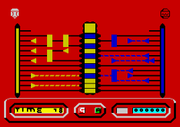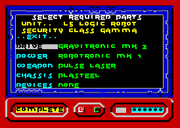
Quazatron
Encyclopedia
Quazatron is an action
video game genre released in 1986
by Graftgold
Ltd. It was designed by Steve Turner
for the ZX Spectrum
.
, which was written by Graftgold partner Andrew Braybrook
in 1985. Although a direct conversion was considered, it was felt that the Spectrum couldn't handle screen-scrolling as smoothly as the Commodore 64. However, Steve Turner had been working on an isometric landscape engine for the Spectrum called Ziggurat and decided to use this with the Paradroid game mechanics, control system and patrol paths.
This new isometric perspective (drawing visual comparisons with Marble Madness
) also provided an additional gameplay aspect – opposing droids could be pushed off edges in order to damage them.
Each robot has a two-character identifier which provides information about its parts and role. 'X' denotes a menial robot, 'U' for utility, 'R' for repair, 'B' for battle, 'L' for logic, 'S' for security and 'C' for command. The number is a ranking system, with lower numbers denoting better parts. '9' is a 'device', '8' or '7' for a drone, '6' or '5' for a robot, '4' or '3' for a droid, '2' or '1' for a cyborg. This ranking also determines the robot's security rating from Epsilon to Alpha. Security rating determines the level of access from information points. In addition are several special identifiers; 'OO Medic Droid', 'A1 Automaton', 'ST Programmer' and 'AB Andrewoid'. (The last two being plays on Steve Turner & Andrew Braybrook's names.)
 To grapple another robot, Klepto must make contact with it with the grapple activated. This initiates a sub-game in which both parties must light sections at the centre of a circuit board using a limit number of power supplies. Should Klepto win, the player may attempt to salvage parts from the destroyed enemy, with a more dominating victory providing less damaged equipment.
To grapple another robot, Klepto must make contact with it with the grapple activated. This initiates a sub-game in which both parties must light sections at the centre of a circuit board using a limit number of power supplies. Should Klepto win, the player may attempt to salvage parts from the destroyed enemy, with a more dominating victory providing less damaged equipment.
 Parts include:
Parts include:
If Klepto is sufficiently damaged, it will lose all acquired parts and be left with its default loadout. The player must then seek immediate repairs or risk losing the game completely. Klepto's damage level is denoted by the expression on his face, rather than an energy bar. These facial expressions, including eye blinks and looks, were inspired by Andrew Braybrook's animation techniques for Gribbly's Day Out
.
When the first location, Quazatron, has been completely cleared, Klepto proceeds to the next citadel, Beebatron (a reference to a rival microcomputer, the BBC Model B or "Beeb"). Subsequent citadels, Commodo and Amstrados, are also named after microcomputers of the era.
reviewed the game in issue 6, awarding 9 out of 10, with reviewer Phil South highlighting the original scenario and combination of strategy and action. CRASH
was similarly impressed, awarding 94% in issue 29 and highlighting the graphics, sound effects, playability and addictiveness. Sinclair User
awarded the game a 'Sinclair User Classic' award in their May 1986 issue. In their issue 51 retrospective, CRASH concluded that Quazatron was a successful fusion of arcade action and strategy, superior to the original Paradoid.
One common criticism was with the game's slow and jerky screen scrolling, despite Hewson claiming that problem would be fixed by the game's release.
Quazatron has also provided inspiration for several PC remakes.
Action game
Action game is a video game genre that emphasizes physical challenges, including hand–eye coordination and reaction-time. The genre includes diverse subgenres such as fighting games, shooter games, and platform games, which are widely considered the most important action games, though some...
video game genre released in 1986
1986 in video gaming
-Events:-Notable releases:*Namco releases Sky Kid Deluxe, Hopping Mappy, Toy Pop, The Return of Ishtar, which is the sequel to Tower of Druaga, Genpei Tōma Den, and Rolling Thunder....
by Graftgold
Graftgold
Graftgold was an independent computer game developer that came to prominence in the 1980s, producing numerous computer games on a variety of 8-bit, 16-bit and 32-bit platforms.-The Hewson era:...
Ltd. It was designed by Steve Turner
Steve Turner (game programmer)
Steve Turner was a computer game musician and designer. His development team, Graftgold, mostly wrote for games published by Hewson Consultants during the 1980s....
for the ZX Spectrum
ZX Spectrum
The ZX Spectrum is an 8-bit personal home computer released in the United Kingdom in 1982 by Sinclair Research Ltd...
.
History
Quazatron was a Spectrum version of ParadroidParadroid
Paradroid is a Commodore 64 computer game written by Andrew Braybrook and published by Hewson Consultants in 1985. It was also remade as Paradroid 90 for the Amiga and Atari ST home computers and as Paradroid 2000 for the Acorn Archimedes. There exist several fan-made remakes for modern PCs...
, which was written by Graftgold partner Andrew Braybrook
Andrew Braybrook
Andrew Braybrook is a software engineer, a former game programmer. He created video games such as Paradroid, Gribbly's Day Out, Fire and Ice, Uridium and Morpheus. He also programmed the Commodore Amiga conversion of the arcade game Rainbow Islands.Braybrook started out writing accounting programs...
in 1985. Although a direct conversion was considered, it was felt that the Spectrum couldn't handle screen-scrolling as smoothly as the Commodore 64. However, Steve Turner had been working on an isometric landscape engine for the Spectrum called Ziggurat and decided to use this with the Paradroid game mechanics, control system and patrol paths.
This new isometric perspective (drawing visual comparisons with Marble Madness
Marble Madness
Marble Madness is an arcade video game designed by Mark Cerny, and published by Atari Games in 1984. It is a platform game in which the player must guide an onscreen marble through six courses, populated with obstacles and enemies, within a time limit. The player controls the marble by using a...
) also provided an additional gameplay aspect – opposing droids could be pushed off edges in order to damage them.
Storyline
In Quazatron, the player-controlled droid (KLP-2 "Klepto", from the Classical Greek κλεπτω, steal) attempts to destroy all the other robots in the underground citadel of Quazatron and subsequent locations.Gameplay
Klepto is maneuvered across individual levels of Quazatron, which can be navigated between via a system of lifts. Levels may include floors at different heights, ramps, information points, recharge points and patrolling robots. It is Klepto's aim to destroy all the other robots, whereupon the lighting on that level is deactivated. This can be done by damaging them with a ranged weapon, by ramming into them and/or causing them to fall from a height, or by a successful grapple attempt.Each robot has a two-character identifier which provides information about its parts and role. 'X' denotes a menial robot, 'U' for utility, 'R' for repair, 'B' for battle, 'L' for logic, 'S' for security and 'C' for command. The number is a ranking system, with lower numbers denoting better parts. '9' is a 'device', '8' or '7' for a drone, '6' or '5' for a robot, '4' or '3' for a droid, '2' or '1' for a cyborg. This ranking also determines the robot's security rating from Epsilon to Alpha. Security rating determines the level of access from information points. In addition are several special identifiers; 'OO Medic Droid', 'A1 Automaton', 'ST Programmer' and 'AB Andrewoid'. (The last two being plays on Steve Turner & Andrew Braybrook's names.)


- Power (ranging from the initial Chemifax Mk1 to the Cybonic Mk2), which provides power to all components, but more powerful units weigh more.
- Drive (ranging from Linear Mk1 to Ultragrav), which consumes power but determines a robots speed. Overall speed is also reduced by the weight of all the parts.
- Chassis (ranging from Duralite to Coralloy Mk2) which determines a robots ability to take damage, but may consume power and has weight.
- Weapon (ranging from a Pulse Laser to a Disruptor) which consumes power and has weight.
- Devices have extra weight and may consume power.
- Detector displays active levels on the map screen.
- Overdrive provides extra drive, whilst Powerboost provides extra power.
- Laser Shields and Disruptor Shields provide extra defence against certain weapons.
- Ram Thruster causes extra damage when ramming.
If Klepto is sufficiently damaged, it will lose all acquired parts and be left with its default loadout. The player must then seek immediate repairs or risk losing the game completely. Klepto's damage level is denoted by the expression on his face, rather than an energy bar. These facial expressions, including eye blinks and looks, were inspired by Andrew Braybrook's animation techniques for Gribbly's Day Out
Gribbly's Day Out
Gribbly's Day Out is a Commodore 64 game by Andrew Braybrook, released by Hewson in 1985. The game is set on the planet Blabgor and centred on the exploits of Gribbly Grobbly and his attempts to rescue errant 'gribblets' from the landscape and return them to safety.-The heroes:Blabgorians possess...
.
When the first location, Quazatron, has been completely cleared, Klepto proceeds to the next citadel, Beebatron (a reference to a rival microcomputer, the BBC Model B or "Beeb"). Subsequent citadels, Commodo and Amstrados, are also named after microcomputers of the era.
Critical reaction
Your SinclairYour Sinclair
Your Sinclair or YS as it was commonly abbreviated, was a British computer magazine for the Sinclair range of computers, mainly the ZX Spectrum.-History:...
reviewed the game in issue 6, awarding 9 out of 10, with reviewer Phil South highlighting the original scenario and combination of strategy and action. CRASH
CRASH (magazine)
Crash was a magazine dedicated to the ZX Spectrum home computer. It was published from 1984 to 1991 by Newsfield Publications Ltd until their liquidation, and then until 1992 by Europress.-Development:...
was similarly impressed, awarding 94% in issue 29 and highlighting the graphics, sound effects, playability and addictiveness. Sinclair User
Sinclair User
Sinclair User, often abbreviated SU, was a magazine dedicated to the Sinclair Research range of home computers, most specifically the ZX Spectrum...
awarded the game a 'Sinclair User Classic' award in their May 1986 issue. In their issue 51 retrospective, CRASH concluded that Quazatron was a successful fusion of arcade action and strategy, superior to the original Paradoid.
One common criticism was with the game's slow and jerky screen scrolling, despite Hewson claiming that problem would be fixed by the game's release.
Ports and sequels
Quazatron was followed by a 1988 sequel, Magnetron.Quazatron has also provided inspiration for several PC remakes.

